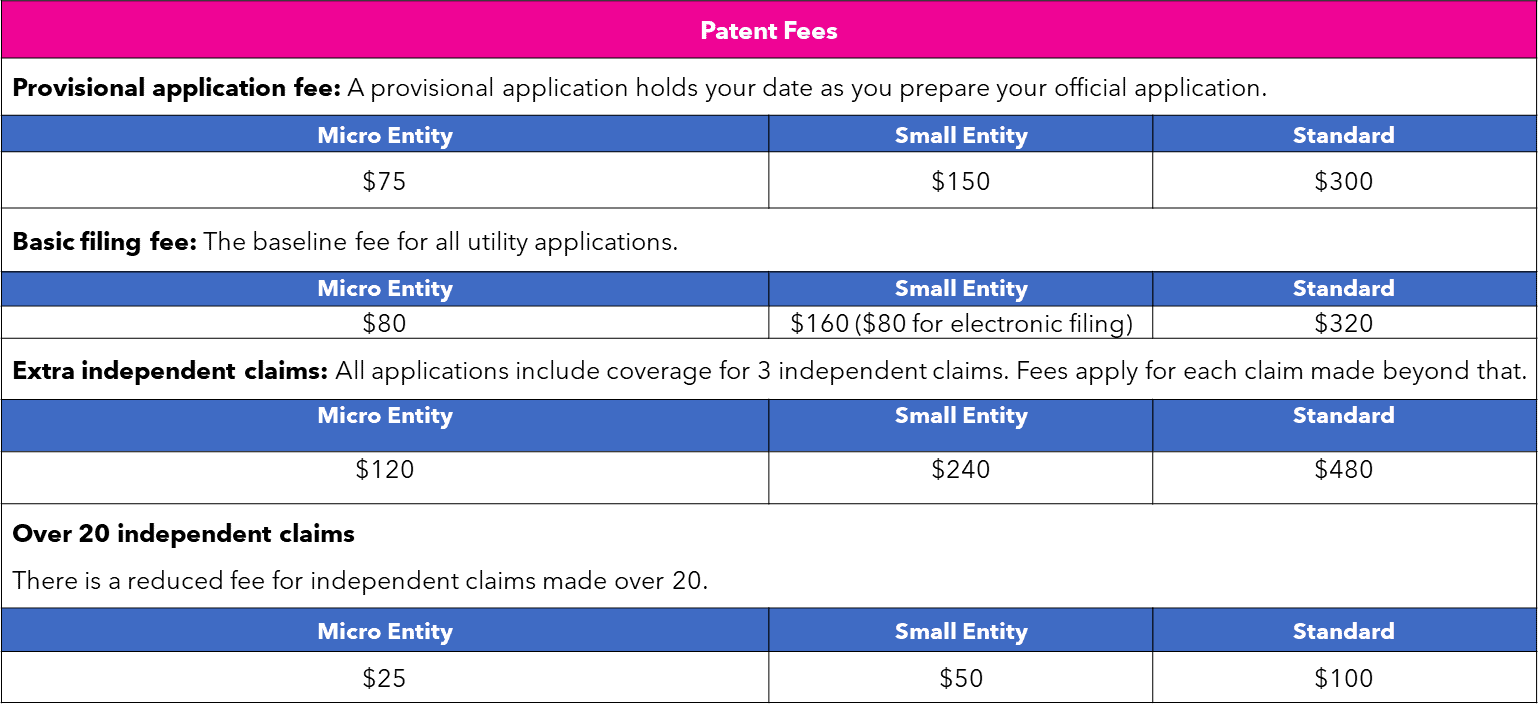When reviewing how much a utility patent costs, you must consider both the direct filing fees, attorney fees, and the less obvious expenses. Overall, it’s a process that usually runs from $10,000 to $40,000. However, while there’s a lot of paperwork involved, that’s not where the brunt of your costs will come in.
They come from the due diligence it takes to get a patent granted. There are thousands of hopeful applicants every year, and more than half of all first-time applications are denied. So, as you consider the costs, you also have to understand the expenses that successful applicants incur. This is not an area to cut corners.
How Much Is a Utility Patent? Breaking Down the Costs
The most straightforward patent costs you’ll deal with will be for the application submission with the United States Patent and Trademark Office. These are the basic fees to expect.
There are a few fees to note in the above chart. The provisional patent application is not required but is recommended if you want to go public or need some time to refine your idea.
You also may have noted the mention of “claims”. Claims are the specific assertions that you’re making in your patent. They are the things that are protected. For example, a very simplistic independent claim would be, “I invented a wearable device capable of detecting skin cancer.” That would be the protected idea in your application. You’re allowed three claims in a basic application, but you may need more if you have a complex invention.
Fees are based on your entity size because the very purpose of patents is to spur innovation. As a result, new entrepreneurs enjoy reduced costs compared to larger companies. Individual inventors typically qualify as small or micro-entities.
It’s essential to remember that these fees are specific to utility patents. If you’re seeking a design or plant patent, then the costs are different.
Why Are Design and Plant Patents Cheaper?
Design and plant patent applicants pay $220, $110, or $55, depending on their size. The reduced cost of design patents is linked to their simplicity. While no patent is exactly simple, it’s far easier to review the aesthetic of something than it is to understand its deeper function. The design patent covers precisely what’s submitted in the required drawing, making it a pretty straightforward examination process.
Plant patents are similar, though they apply specifically to seeds, fruits, and, obviously, plants. The goal of the Plant Patent Act of 1930 was to encourage plant breeding and genetic diversity for the good of society. Therefore, the patent examination process set forth by this act is not as stringent as one for a utility patent, making such applications easier to review.
Of course, just because they’re cheaper doesn’t mean you can use them to cut costs. If you’re protecting function, then you need a utility patent. But there are more than just USPTO fees to consider in that application.
Where Utility Patent Costs Come From
As previously stated, a utility patent may cost anywhere from $10,000 to $40,000. However, the USPTO only appears to take a small portion of that. So, where do all these expenses come from? They are related to the steps you take to ensure your patent is approved. Successful applicants invest in a few different options, like:
- Initial legal opinions: The initial legal opinion will tell an inventor if they have a patentable idea. The attorney will review the concept and give a basic explanation of its likelihood of approval. The $200 to $400 expense helps you avoid spending thousands on nonviable ideas.
- Search and opinion: The search and opinion step is a deeper dive than basic patentability. It centers on searching for ideas that could disqualify yours. The attorney will obtain a patent search to determine if there are conflicting products and complete a legal opinion. They may also review prior art—which is publicly available information that could affect patentability. The cost of this varies depending on the depth, ranging from $500 to $5,000 or more.
- Drawings and diagrams: While utility patent applications do not require drawings, we highly recommend including them. The cost will depend on the artist’s experience, though it can reach more than $100 per figure.
A big part of how much a utility patent costs will depend on the inventor’s path, whether they seek legal advice or go DIY. While some inventors are tempted to go the DIY route to cut costs, this can result in charges that mount as they try to correct mistakes. The best way to keep costs predictable is to work with an attorney for the entire process.
Bold Patents helps you control how much a utility patent costs by offering you an end-to-end, predictable solution. Contact us online or by phone at 800-849-1913 for more details.


